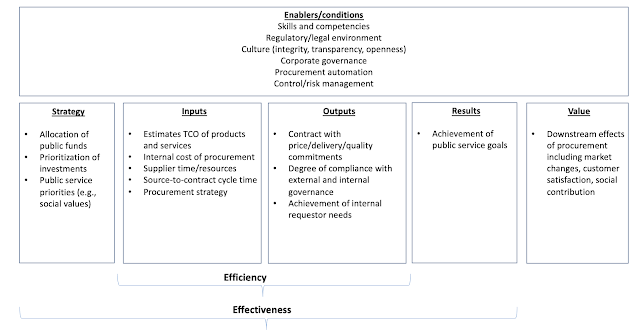The public procurement process should be about value, not just savings
What matters most when we elect a public servant - a healthy society, clean and secure environment, quality education - or the savings they deliver?
We expect state officials to manage public spending wisely and obtain the highest value to society for the allocated budget.
Essential macroeconomic functions of government
- allocation function to achieve efficiency,
- redistribution function to achieve equity,
- stabilization function to achieve stability.
Firstly, neither of these functions assumes savings. Those are about spending properly, rectifying inequality, and securing economic stability.
Secondly, this definition recalled a vital term - "efficiency" - and omitted another crucial one - "effectiveness."
Efficiency vs. effectiveness
The memorable quote by Peter Drucker tells us that "efficiency is doing the thing right. Effectiveness is doing the right thing." A view on procurement management efficiency
Efficiency is operational excellence. It is about keeping your house in order and achieving the most with what you have.
Most importantly, it is imitable alongside best practices that many of our bosses are proud of!
Public procurement management efficiency only considers the correlation between inputs (cost estimates, transactional procurement costs, sourcing strategy) and outputs (actual contract conditions, compliance, and fulfillment of a public authority's needs).
Effectiveness is the dynamic capability.
Meanwhile, the concept of procurement effectiveness is far more complex. It controls how government priorities and a public fund strategy translate into the outcomes of the public service goals, per the essential model developed by OECD. 
Effectiveness is classified as one of the dynamic capabilities, the genuine source of competitive advantage.
It is very challenging to measure procurement effectiveness by measuring citizens' satisfaction with public services and thus qualifying value for money.
Therefore, many governments juggle the motto "let's spend less" and reinforce the anachronic low-bid culture.
Efficient but not effective
US PPE Procurement during COVID-19
The US government’s rapid procurement strategy ensured swift delivery of PPE, meeting urgent demand during the pandemic’s peak.
Despite efficiently achieving procurement targets, the process involved high costs, substandard supplies, and dead stock, failing to deliver sustainable value or long-term preparedness.
Health workers filed more than 4,000 complaints about protective gear.
In the Department of Veteran Affairs alone ($4.2 billion PPE spent during pandemics), 66% of contracts have been terminated or reviewed in terms of quantities.
Rhode Island shredded and recycled 829 tons of PPE; Maryland dispensed over $93 million in supplies.
Boeing 737 MAX
The 737 MAX was developed to upgrade the existing 737 model, offering increased fuel efficiency and lower operational costs to compete with the Airbus A320neo. Boeing retained the original design framework to save costs and expedite the launch, avoiding a new certification process with the Federal Aviation Administration (FAA).
Boeing implemented a new software system called the Maneuvering Characteristics Augmentation System (MCAS) to maintain similar flight characteristics despite larger engines. This software was designed to adjust the aircraft’s angle in certain situations automatically, but it relied on input from a single sensor.
This approach helped Boeing achieve procurement efficiency and effectiveness by reducing the time and costs associated with design changes.
However, they compromised safety, trust, and long-term value. The aircraft crashes led to a global grounding of the 737 MAX fleet, lengthy regulatory reviews, and software redesigns. Boeing incurred heavy financial losses, including over $20 billion in direct costs, additional airline compensation, lost orders, and severe reputational damage.
Procurement management must look for customer experience, not just procurement savings!
Therefore, we suggest conscious citizens judge public companies for their effectiveness. To do that, you may start assessing their service level.
Then you'd realize that the cost of services is only an element of the internal quality, which matters to public companies and other operational metrics.
Meanwhile, citizens evaluate public services by
- process,
- customer services,
- facilities,
- information.
Would you evaluate public services by how much money someone saved to provide you with a suboptimal customer experience?
Examples of brave public procurement processes
This post doesn't mean that procurement should not save public money.
Ideally, it shouldn't be obsessed with saving money upfront before the contract signature.
There's no sense in fighting for fluff savings before the end-product delivery or service launch, as that money has no value.
Then procurement only forces vendors to play with the sides of the iron triangle and sacrifice eventual quality to provide discounts from the revenues they have yet to collect.
Brave public procurement should incentivize vendors to deliver value share eventual benefits. Possible realizations of this could be
- PPP (Public-Private Partnerships) can be described as any form of cooperation between government institutions and private sector economic operators to ensure the funding, construction, renovation, management, and maintenance of infrastructure (works) and/or service provision. Eventual payments may come from the contracting authority or infrastructure users (e.g., tollgates.)
- Value-based procurement encourages cooperation between state healthcare institutions and suppliers to provide measurable patient benefits beyond reducing purchase prices.
- Outcome-based procurement involves selecting suppliers based on their capability to deliver against defined outcomes (success criteria) and rewarding them in part or in whole for achieving those outcomes.
- Best-value procurement or MEAT tenders, where the contracting authority considers criteria that reflect qualitative, technical, and sustainable aspects of the tender submission and price when reaching an award decision.
Public procurement management may dilute the uninspired low-bid supplier selection and reinforce its ambition to become the strategic value-generating function with these and some more value- or outcome-based sourcing methods.
P.S. If you appreciate hundreds of hours invested in researching and writing this blog, you can buy me a coffee or subscribe for the membership by following this link. Thank you!
More information on this and other exciting topics can be found in
"The Technology Procurement Handbook." It represents 23 years of experience, billions of dollars worth of successful sourcing projects, and 1000s of hours spent on research, analysis, and content creation for the most demanding professional readers.






Comments
Post a Comment